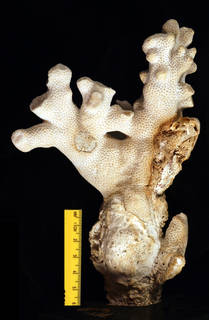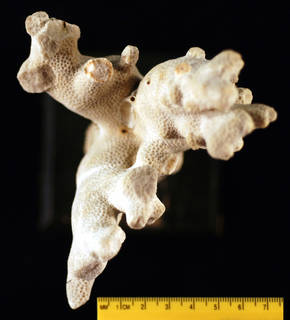
| Intro | | About | | Wiki | | Search traits | | Data explorer | | Literature | | Definitions | | Sources | | Webservices | | Statistics | | Feedback | | Editors | | Log in |
Scleractinia taxon detailsPorites nigrescens Dana, 1846
207234 (urn:lsid:marinespecies.org:taxname:207234)
accepted
Species
Porites (Porites) nigrescens Dana, 1846 · unaccepted > superseded combination
Porites mucronata Dana, 1846 · unaccepted > junior subjective synonym
Porites nigrescens var. mucronata Dana, 1846 · unaccepted > junior subjective synonym
Porites nigrescens var. togianensis Umbgrove, 1940 · unaccepted > junior subjective synonym
Porites saccharata Brüggemann, 1878 · unaccepted > junior subjective synonym
Porites suppressa Crossland, 1952 · unaccepted > junior subjective synonym
marine,
Dana, J.D. (1846-1849). Zoophytes. United States Exploring Expedition during the years 1838-1842. <em>Lea and Blanchard, Philadelphia.</em> 7: 1-740, 61 pls. (1846: 1-120, 709-720; 1848: 121-708, 721-740; 1849: atlas pls. 1-61)., available online at https://www.biodiversitylibrary.org/page/18989497, http://www.sil.si.edu/digitalcollections/usexex/navigation/ScientificText/USExEx19_08select.cfm [details]
Type locality contained in Fijian Exclusive Economic Zone
type locality contained in Fijian Exclusive Economic Zone [details]
Unreviewed
Type locality Fiji (Veron, 1986). [details]
Description Colonies are branching, sometimes with an encrusting base. Concave calices give the surface a pitted appearance. Polyps are...
Description Colonies are branching, sometimes with an encrusting base. Concave calices give the surface a pitted appearance. Polyps are frequently extended during the day. Colour: brown or cream. Abundance: common; occurs frequently with P. cylindrica but also common on lower reef slopes (Veron, 1986). Branching colonies, some with slight scalloping of the surface giving a somewhat rough texture. Colour: often cream or light yellowish-brown. Habitat: deeper reef slopes (Richmond, 1997). [details]
Hoeksema, B. W.; Cairns, S. (2025). World List of Scleractinia. Porites nigrescens Dana, 1846. Accessed at: https://www.marinespecies.org/Scleractinia/aphia.php?p=taxdetails&id=207234 on 2025-07-17
Date action by 2000-09-13 07:19:12Z changed Garcia, Maria
original description
Dana, J.D. (1846-1849). Zoophytes. United States Exploring Expedition during the years 1838-1842. <em>Lea and Blanchard, Philadelphia.</em> 7: 1-740, 61 pls. (1846: 1-120, 709-720; 1848: 121-708, 721-740; 1849: atlas pls. 1-61)., available online at https://www.biodiversitylibrary.org/page/18989497, http://www.sil.si.edu/digitalcollections/usexex/navigation/ScientificText/USExEx19_08select.cfm [details]
original description (of Porites saccharata Brüggemann, 1878) Brüggemann F (1878) Ueber einige Steinkorallen von Singapore. Jahresberichte Naturwissenschaftliger Verein Bremen 3: 539-549. [details] original description (of Porites suppressa Crossland, 1952) Crossland C (1952) Madreporaria, Hydrocorallinae, Heliopora and Tubipora. Scientific Report Great Barrier Reef Expedition 1928-29 VI(3): 85-257. [details] original description (of Porites (Porites) nigrescens Dana, 1846) Dana, J.D. (1846-1849). Zoophytes. United States Exploring Expedition during the years 1838-1842. <em>Lea and Blanchard, Philadelphia.</em> 7: 1-740, 61 pls. (1846: 1-120, 709-720; 1848: 121-708, 721-740; 1849: atlas pls. 1-61)., available online at https://www.biodiversitylibrary.org/page/18989497, http://www.sil.si.edu/digitalcollections/usexex/navigation/ScientificText/USExEx19_08select.cfm [details] original description (of Porites nigrescens var. mucronata Dana, 1846) Dana, J.D. (1846-1849). Zoophytes. United States Exploring Expedition during the years 1838-1842. <em>Lea and Blanchard, Philadelphia.</em> 7: 1-740, 61 pls. (1846: 1-120, 709-720; 1848: 121-708, 721-740; 1849: atlas pls. 1-61)., available online at https://www.biodiversitylibrary.org/page/18989497, http://www.sil.si.edu/digitalcollections/usexex/navigation/ScientificText/USExEx19_08select.cfm [details] original description (of Porites nigrescens var. togianensis Umbgrove, 1940) Umbgrove JHF. (1940). Madreporaria from the Togian Reefs (Gulf of Tomini, North-Celebes. <em>Zoologische Mededelingen, Leiden.</em> 22: 265-310. [details] context source (Hexacorallia) Fautin, Daphne G. (2013). Hexacorallians of the World. (look up in IMIS) [details] basis of record Veron JEN. (1986). Corals of Australia and the Indo-Pacific. <em>Angus & Robertson Publishers.</em> [details] additional source Dunn, D.F., 1970. Some observations on marine life at Pulau Aur, Johore. Malay. Nat. J. 23 : 158-167. page(s): 162 [details] additional source Vaughan TW. (1918). Some shallow-water corals from Murray Island (Australia), Cocos-Keeling Island, and Fanning Island. <em>Papers from the Department of Marine Biology of the Carnegie Institution of Washington.</em> 9 (213): 49-234, pls. 20-93. [details] additional source Quelch J.J. (1886). Report on the Reef-corals collected by H.M.S. 'Challenger' during the years 1873-76. <em>Report on the Scientific Results of the Voyage of H.M.S. Challenger during the years 1873–1876. Zoology.</em> 16 (46): 1-203, pls 1-12., available online at http://www.19thcenturyscience.org/HMSC/HMSC-Reports/Zool-46/README.htm page(s): 19, 202 [details] additional source Dana, J.D. (1846-1847). On Zoophytes. <em>The American Journal of Science and Arts, Second Series.</em> 2(4): 64-69; 2(5): 187-202; 3(7): 1-24; 3(8): 160-163; 3(9): 337-347. New-Haven., available online at https://www.biodiversitylibrary.org/page/28135503 page(s): 551, 557-558 [details] additional source Cairns, S.D., B.W. Hoeksema & J. van der Land. (1999). Appendix: List of extant stony corals. <em>Atoll Research Bulletin.</em> 459: 13-46. page(s): 38 [details] additional source Robertson R. (1970). Review of the predators and parasites of stony Corals, with special reference to symbiotic Prosobranch Gastropods. <i>Pacific Science 24 (1)</i>: 43-54 page(s): 48 [details] additional source Cairns, S.D., B.W. Hoeksema & J. van der Land. (2007). as a contribution to UNESCO-IOC Register of Marine Organisms. (look up in IMIS) [details] additional source Liu, J.Y. [Ruiyu] (ed.). (2008). Checklist of marine biota of China seas. <em>China Science Press.</em> 1267 pp. (look up in IMIS) [details] Available for editors additional source Rehberg, H. (1892). Neue und wenig bekannte Korallen. <em>Abhandlungen aus dem Gebiete der Naturwissenschaften Hamburg.</em> 12: 1-50. page(s): 46, 47 [details] additional source Nemenzo, F. (1955). Systematic studies on Philippine shallow water scleractinians: I. Suborder Fungiida. <em>Natural and Applied Science Bulletin, University of the Philippines.</em> 15: 3-84. page(s): 6, 28, 31-32, Plate VII, fig. 1 [details] additional source Veron JEN. (2000). Corals of the World. Vol. 1–3. <em>Australian Institute of Marine Science and CRR, Queensland, Australia.</em> [details] additional source Veron JEN. (2002). New species described in Corals of the World. <em>Australian Institute of Marine Science Monograph Series.</em> 11: 1-209. page(s): 182, 187 [details] additional source Umbgrove JHF. (1940). Madreporaria from the Togian Reefs (Gulf of Tomini, North-Celebes. <em>Zoologische Mededelingen, Leiden.</em> 22: 265-310. page(s): 267, 268, 272, 305, 310, Pl. XXXIV [details] additional source Yabe H, Sugiyama T. (1935). Revised list of the reef-corals from the Japanese seas and of the fossil reef corals of the raised reefs and the Ryukyu limestone of Japan. <em>Journal of the Geological Society of Japan.</em> 42: 379-403. page(s): 401 [details] additional source Milne Edwards H, Haime J (1851) Recherches sur les polypiers. Mémoire 7. Monographie des Poritides. Annales des Sciences Naturelles, Zoologie, Series 3, 16: 21-70. page(s): 32 [details] additional source Pichon, M.; Benzoni, F. (2007). Taxonomic re-appraisal of zooxanthellate Scleractinian Corals in the Maldive Archipelago. <em>Zootaxa.</em> 1441: 21–33. page(s): 31 [details] additional source Faustino LA. (1927). Recent Madreporaria of the Philippine Islands. <em>Bureau of Science Manila Monograph.</em> 22: 1-310, pls. 1-100. page(s): 20, 27, 42, 290-291, 292 [details] additional source Veron JEN, Marsh LM. (1988). Hermatypic corals of Western Australia : records and annotated species list. <em>Records Western Australian Museum Supplement.</em> 29: 1-136., available online at https://doi.org/10.5962/bhl.title.60555 page(s): 33, 66 [details] additional source Boshoff, P.H. (1981). An annotated checklist of Southern Africa Scleractinia. <em>Oceanographic Research Institute Investigational Report, Durban.</em> 49: 1-45. page(s): 19 [details] additional source Umbgrove JHF. (1924). Report on Plistocene and Pliocene corals from Ceram. <em>Geological, Petrographical, and Paleontological Results of explorations carried out from September 1917 till June 1919 in the island of Ceram, Second Series: Palaeontology.</em> 1: 1-22, map, pls. 1-2. [details] additional source Rathbun, R. (1887). Annotated catalogue of the species of Porites and Synaraea in the U.S.N.M., with the description of a new species of Porites. Proceedings of the United States National Museum, 10: 354-366 page(s): 365 [details] additional source Rehberg, H. (1893). Neue und wenig Bekannte Korallen. <em>Abhandlungen der Naturwissenschaften Verein, Hamburg.</em> 12, 1-50. page(s): 47 [details] additional source Veron, J. E. N. (2000). Corals of the World, Volume III: Families Mussidae, Faviidae, Trachyphylliidae, Poritidae. Australian Institute of Marine Science. Townsville., volume 3, pp. 490. page(s): 334-335 [details] additional source Ryland, J. S. (1981). Reefs of southwest Viti Levu and their tourism potential. Proceedings of the Fourth International Coral Reef Symposium, 1, 293-298 page(s): 296-297 [details] additional source Astalhov, D. A. (2002). Species composition of anemonefishes (Perciformes, Pomacentridae) and their host sea anemones (Cnidaria, Actiniaria) in the Khanhhoa Province (South Vietnam). Journal of Ichthyology, 42(1): 37-50 page(s): 41 [details] additional source Sheppard, C. R. C. (1985). Fringing reefs in the southern region, Jeddah to Jizan. Fauna of Saudi Arabia, 7, 37-58 page(s): 46 [details] additional source Kühlmann, D. H. H. (2006). Die Steinkorallensammlung im Naturhistorischen Museum in Rudolstadt (Thüringen) nebst ökologischen Bemerkungen. Rudolstädter Naturhistorische Schriften, 13, 37-113 page(s): 62, 87, 112 [details] additional source Dana, J. D. (1849). Atlas. Zoophytes. C. Sherman. Philadelphia., pp. 12-01 page(s): 11, 557 [details]  Present Present  Inaccurate Inaccurate  Introduced: alien Introduced: alien  Containing type locality Containing type locality
Nontype (of Porites mucronata Dana, 1846) BMNH, geounit Chinese Exclusive Economic Zone [details]
Nontype (of Porites suppressa Crossland, 1952) HLD X2: 151-4, geounit Indian Exclusive Economic Zone [details]
Nontype NMSR 8972, geounit Sri Lankan Exclusive Economic Zone [details]
Nontype WAM 437-85, geounit Australian Exclusive Economic Zone [details]
Nontype WAM 456-85, geounit Australian Exclusive Economic Zone [details]
Nontype WAM 476-85, geounit Australian Exclusive Economic Zone [details]
Nontype WAM 501-86, geounit Ashmore-Cartier Is. [details]
Nontype WAM 544-86, geounit Ashmore-Cartier Is. [details]
Nontype WAM 556-86, geounit Ashmore-Cartier Is. [details]
Nontype WAM 591-86, geounit Ashmore-Cartier Is. [details]
Nontype WAM 724-86, geounit Ashmore-Cartier Is. [details]
Nontype WAM 825-85, geounit Australian Exclusive Economic Zone [details]
Nontype WAM 867-85, geounit Australian Exclusive Economic Zone [details]
Nontype WAM 924-86, geounit Ashmore-Cartier Is. [details]
Unknown type MSI C-59, geounit Philippine Exclusive Economic Zone [details]
From editor or global species database
Biology zooxanthellate [details]Unreviewed
Description Colonies are branching, sometimes with an encrusting base. Concave calices give the surface a pitted appearance. Polyps are frequently extended during the day. Colour: brown or cream. Abundance: common; occurs frequently with P. cylindrica but also common on lower reef slopes (Veron, 1986).Branching colonies, some with slight scalloping of the surface giving a somewhat rough texture. Colour: often cream or light yellowish-brown. Habitat: deeper reef slopes (Richmond, 1997). [details] Type locality Fiji (Veron, 1986). [details]
To Barcode of Life
To Biodiversity Heritage Library (18 publications) (from synonym Porites suppressa Crossland, 1952) To Biodiversity Heritage Library (26 publications) To Biodiversity Heritage Library (5 publications) (from synonym Porites saccharata Brüggemann, 1878) To Biological Information System for Marine Life (BISMaL) To European Nucleotide Archive, ENA (Porites nigrescens) To GenBank (10 nucleotides; 1 proteins) To IUCN Red List (Least Concern) To NMNH Extant Collection (IZCOE690wholecolony) To NMNH Extant Collection (IZCOE690wholeupper) To USNM Invertebrate Zoology Cnidaria Collection (1 record) (from synonym Porites suppressa Crossland, 1952) To USNM Invertebrate Zoology Cnidaria Collection (57 records) To ITIS |


